(A 3D illustration of the widely debunked competing conspiracy theory that the Earth is flat, as it appears from land, rather than spherical. Earth texture maps courtesy of NASA.gov. Image via Shutterstock.)
Jainavenue is a medium to serve the spiritual path of Jainism
Round Earth “Theory” is Western Propaganda, According to This Indian Flat Earther
April, 2024 by Sushmita Sundaram
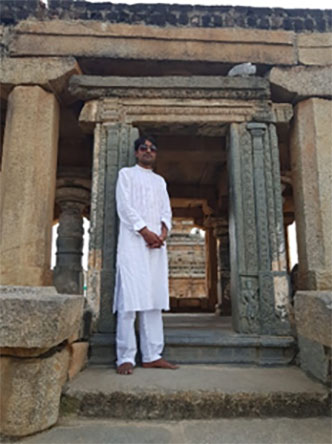
(Gaurav Jain is questioning something we were told and have believed in since we were kids: that Earth is a globe.)
While Jain’s test anxiety is a sentiment one can empathise with (who hasn’t learned the ancient Indian art of mugging for an exam?), you would think that the earth being a sphere is an incontrovertible fact. But this didn’t stop flat earthers from bamboozling scientists with the clever use of canals in the mid 20th century and it isn’t stopping them now, especially with some celebrity names to add to the roster: basketball star Kyrie Irving has publicly proclaimed his belief in a flat earth and rapper B.o.B has started beef with astrophysicist and resident Twitter fun-killer, Neil DeGrasse Tyson with his diss track “Flatline”.
Despite a worrisome number of Indians believing that gaumutra (cow pee) will cure cancer, handing someone a knife will cause a souring of interpersonal relations, and cutting your nails on a Thursday causes the world to end, sincere desi Flat Earthers are hard to find. They seem to largely consist of holocaust deniers, conspiracy theory junkies, and the occasional biblical literalist, per this Reddit thread. The most ardent Indian believers of Flat Earth Theory, instead, are a small minority of a religion otherwise known for its gentle inoffensiveness: Jainism. Between four or five million Jains (followers of Jainism often have Jain as a last name, confusingly enough, like in the case of Gaurav Jain), primarily based in India, follow this non-theistic, nonviolent way of life. You have likely seen them in busy Indian metros walking to their derasars (temples), freshly showered, dressed in simple white robes, and barefoot so as to lessen the harm to ants they might trod on.
Like many other religions, Jain doctrine too has its interpretation of how the universe is designed. Jain cosmology proposes the existence of two sets of suns, moons, and stars, of which only one set is visible to the naked eye. The other is hidden behind Mount Sumeru, which is the centre of Jambudvipa (the continent or island where our Earth is), which in turn exists in Madhya Loka, home to humans and animals. Madhya Loka consists of islands (of which Jambudvipa is one) surrounded by concentric circles of oceans. A full-scale, detailed model of this design can be experienced in Hastinapur, Uttar Pradesh, where the Digambar Jain Institute of Cosmographic Research at the Jambudweepa temple was built in 1972 to promote Jain mythology and philosophy.
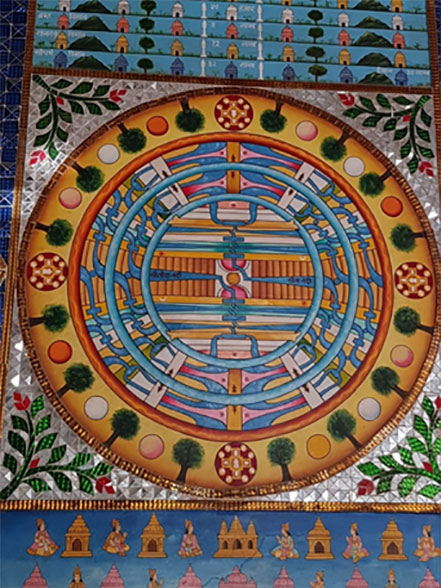
(Shravanabelagola, a centre of pilgrimage (tirtha) for the Jains, has a pictorial representation of the Jain cosmology)
But back to Gaurav Jain, who just wanted to do well in his exams. Jain believed in standard geography like the rest of us until he watched James Cameron’s Avatar. His curiosity was piqued. “I really liked that movie. I wanted to know everything: How long is the universe? Where do other people [lifeforms] live? I then thought of searching ancient books, to see if they would tell us the truth,” Jain shares. “A friend of mine who was studying Jainism referred some to me. Around this time, I had opened my own office after qualifying as a chartered accountant, so I had a lot of time on my hands. One day I went to a talk, where a guruji described [Mount] Sumeru, how there are two suns, and how they go around Sumeru in a circle, like a jalebi.” Jain found himself spending the next few years hunting down ancient texts, teaching himself Jain Prakrit (the language Jain literature is often written in), and touring temples to see what their carvings and paintings had to say about the world. As he delved deeper into this cosmology based on Jainism, he began to test what he was reading for himself. He also began connecting with fellow Jains with similar beliefs. His world-view was altered.
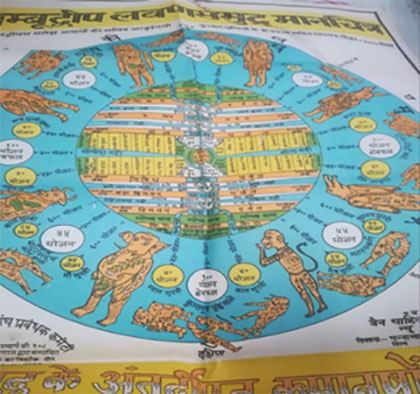
(The Jambudvipa map shows the continent or island where our Earth is, which in turn exists in Madhya Loka, home to humans and animals.)
“After I got into this, my perception on life, on humanity, and my soul changed. These books weren’t just talking about the universe, but also how the soul can achieve salvation, why we’re born in the family and place we are, and time. When you know Page 1 is correct [in these ancient books Jains studied] from your own research, then you have to believe the rest also. The Round Earth theory is western propaganda,” Jain emphasises.
The timing of this transformation is no coincidence. In 2014, the world was getting more fraught—a divisive politician had just been elected, climate change was becoming a real threat in the public consciousness, and social inequalities were widening dramatically. “I got to know that this universe is so big! It is 343 cubed rajju [a Jain unit of measurement that cannot be imagined by the human mind]. We could be anything in this big universe, but because of my deeds, my karma, I become a human. So, if I waste this life, I don’t know where I would end up in my next life,” says Jain. “Accepting the Flat Earth theory would make humans more compassionate, because we would understand how rare we are as a species, compared to trees, plants, animals, etc. We are at the top of [the food chain], so we are the protectors of this world; we have to be compassionate. If we’re not, we could be born anywhere in this 343 rajju, thanks to our [bad] karma.”
Jambu Island
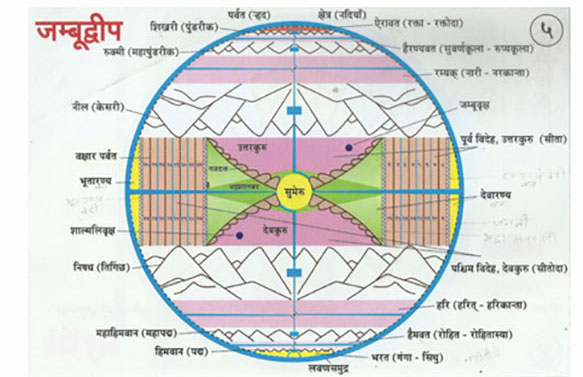
(According to Jain (and Jainism), we live in the southernmost part of Jambu Island (what you see in yellow right at the very bottom).
For Jain, Flat Earth theory functions as motivation to be a better human. He believes that it encourages people to treat the world more kindly, in order to not be reborn as a dung beetle in some far flung corner of the seemingly immeasurable, endless Jain universe.
Gaurav Jain is a true believer. He claims to have finally seen the two suns described in Jain cosmology during a trip in 2016 to a conference on veganism in Klagenfurt, Austria. Taking advantage of his Schengen visa which allowed him entry into several European countries, Jain took a pleasure trip to Venice, Italy. On a Venetian beach, just before twilight, he noticed a phenomenon he had only read about thus far. “I have seen it with my own eyes,” Jain exclaims. His excitement is palpable even over a crackling phone line years later. “I was at the beach, just taking a few photos on my phone, when I noticed I could see light from two different places. I sent a picture to my sister and she immediately called me, saying, “Bhaiyya (brother), you found it! You found the two suns!”
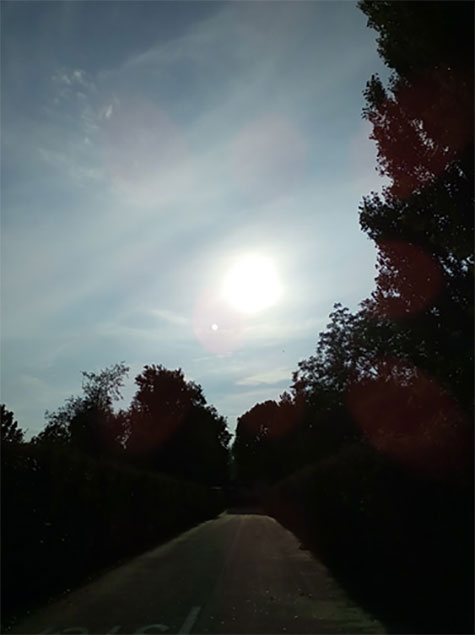
(Jain claims to have finally seen the two suns described in Jain cosmology during a trip in 2016 to a conference on veganism in Klagenfurt, Austria. Look at the photo closely to figure what Jain believes are two suns)
Jain waited for evening to set in, so he could take more pictures with lower ambient light. He is quick to nix the idea that it was the moon: “I checked my thithi (Hindu lunar calendar), and that day there was only a half moon, not a full moon. So the two suns were clearly visible.”
Jain trusts that this Flat Earth Theory led by cosmology based on Jainism has changed his life for the better. He now spends his days teaching classes on Flat Earth Theory and other Jain philosophy, travels more in pursuit of evidence, and likely has a more exciting social life than Round Earthers who spend their weekends lost in a Netflix black hole. He no longer spends time brooding over rapes and murders that dominate headlines. This is the calmest he has been during election season. For flat earthers like Gaurav Jain, their perception of the cosmos seems to lend some sense of meaning and control to their role in the universe.
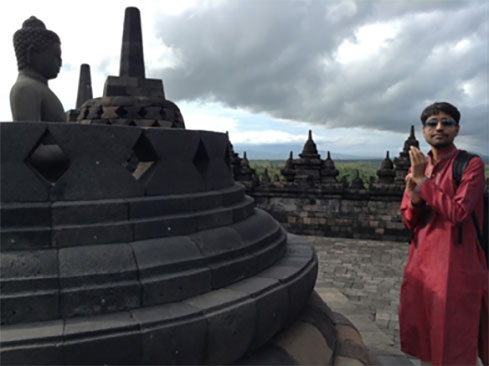
(Jain at Borobudur Temple, a 9th-century Mahayana Buddhist temple, in Central Java, Indonesia. Buddhism’s cosmology has much in common with modern proponents of Flat Earth cosmology.)
Dr. Ravinder Banyal, a research scientist at the Indian Institute of Astrophysics in Bengaluru, India, offers a more pragmatic perspective. “A literal reading of religious scriptures misleads people. Once they read something, they really want to rationalise it further and find evidence for their beliefs,” he explains. “Right now, we are still trying to see if life exists out there. We know that there are more planets than stars. Every star we see has one or more around it. There is a high possibility that there are Earth-like planets that can sustain life in our galaxy or others. We just haven’t definitively found it yet. These are philosophical questions that we weren’t able to answer in the past. But now science is beginning to answer it. But the question of life itself is going to be answered only several decades from now. And there may be more surprises than what religious texts or our minds can imagine.”
But isn’t this desire to find existential meaning the purpose of science itself? In his seminal work, Carl Sagan—leading American science communicator and cosmologist—created an emotional connect that stretched across the universe for millions of future science nerds by pointing out that we were all made of star stuff. This desire to find existential meaning could be be the purpose of science itself. Dr. Banyal more or less agrees: “When you look at the stars in the night sky, a scientist gets as excited as an ordinary person. That results in an urge to know more, to explore things. The question is about the route we take: Does it take us to the truth or does it just give us some peace of mind?”
Acknowledgement:

Simply wish to say your article is as amazing The clearness in your post is just nice and i could assume youre an expert on this subject Well with your permission let me to grab your feed to keep updated with forthcoming post Thanks a million and please carry on the gratifying work
Wonderful web site Lots of useful info here Im sending it to a few friends ans additionally sharing in delicious And obviously thanks to your effort
you are in reality a good webmaster The website loading velocity is amazing It sort of feels that youre doing any distinctive trick Also The contents are masterwork you have done a fantastic job in this topic